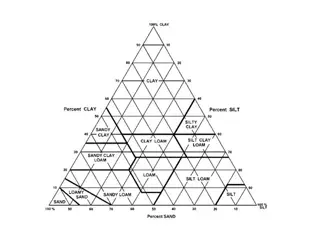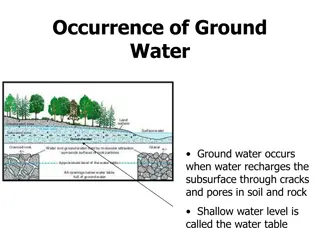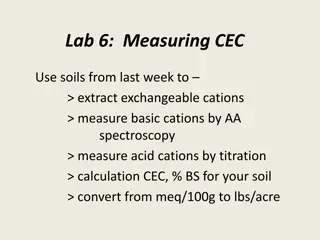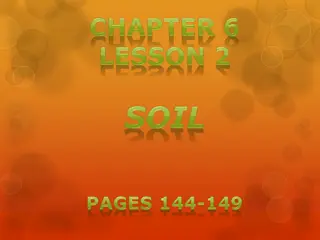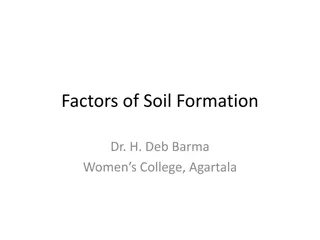Understanding the Importance of Soil and Groundwater Measurements
Explore the significance of infiltration and hydraulic conductivity measurements in environmental studies, training sessions offered by Eijkelkamp Training & Consultancy, and various reasons for conducting measurements such as defining drain distance, disconnecting rainwater, soil and groundwater pollution, erosion sensibility, and drainage problems. Discover how to determine infiltration velocity and depth, as well as discharge and infiltration capacity of wells. Delve into different groundwater zones to understand the dynamics of water movement in soil and groundwater levels.
- Soil and Groundwater
- Environmental Studies
- Eijkelkamp Training
- Water Research
- Infiltration Measurement
Download Presentation

Please find below an Image/Link to download the presentation.
The content on the website is provided AS IS for your information and personal use only. It may not be sold, licensed, or shared on other websites without obtaining consent from the author. Download presentation by click this link. If you encounter any issues during the download, it is possible that the publisher has removed the file from their server.
E N D
Presentation Transcript
Titel Meet the difference
Infiltration and hydraulic conductivity measurements Meet the difference 2 Eijkelkamp Training & Consultancy voor trainingen in milieu- land- en wateronderzoek
Why measurements? Define drain distance Rootzone Watertable 3 Eijkelkamp Training & Consultancy voor trainingen in milieu- land- en wateronderzoek
Why measurements? Disconnect rainwater from sewersystem: infiltration in soil 4 Eijkelkamp Training & Consultancy voor trainingen in milieu- land- en wateronderzoek
Why measurements? Soil and groundwaterpollution: velocity of movement 5 Eijkelkamp Training & Consultancy voor trainingen in milieu- land- en wateronderzoek
Why measurements? Erosion sensibility 6 Eijkelkamp Training & Consultancy voor trainingen in milieu- land- en wateronderzoek
Why measurements? Define infiltration velocity and depth 7 Eijkelkamp Training & Consultancy voor trainingen in milieu- land- en wateronderzoek
Why measurements? Drainage problems: waterponding File:Tusveld wateroverlast.JPG 8 Eijkelkamp Training & Consultancy voor trainingen in milieu- land- en wateronderzoek
Why measurements? Define disscharge and infiltrationcapacity of wells 9 Eijkelkamp Training & Consultancy voor trainingen in milieu- land- en wateronderzoek
Saturated and unsaturated zone Groundwater zones surface) Hangwater zpendiculair zoneone drilli ng hole Unsaturated zone Soilwater zone Open capillaire zone full capillaire zone Saturated zone groundwaterlevel grounwaterzone water 10 Eijkelkamp Training & Consultancy voor trainingen in milieu- land- en wateronderzoek
Infiltration Infiltration is a complex process, differences by soilconditions and precipitation Uniform moistening Preferential flow Increasing complexibility 11 Eijkelkamp Training & Consultancy voor trainingen in milieu- land- en wateronderzoek
Infiltration What does the result mean ? K=< 5 cm/day K= 5-40 cm/day average permeability K= 40-100 cm/day K=>100 cm/day very high permeability bad permeability good permeability 12 Eijkelkamp Training & Consultancy voor trainingen in milieu- land- en wateronderzoek
Infiltration Soil gravel Coarse sand Fine/coarse sand Fine sand Clayey sand Sandy clay Clay Peat k in m/d 30-75 >75 10-30 1-10 10-2-1 10-3-10-1 10-4-10-2 10-4 - 25 13 Eijkelkamp Training & Consultancy voor trainingen in milieu- land- en wateronderzoek
Infiltration Before starting an infiltration measurement always make a soil profile. 14 Eijkelkamp Training & Consultancy voor trainingen in milieu- land- en wateronderzoek
Infiltration Saturated infiltration Unsaturated infiltration 15 Eijkelkamp Training & Consultancy voor trainingen in milieu- land- en wateronderzoek
Infiltration Surface infiltration Falling head (double ring) Unsaturated (tensio infiltro) Sub surface Guelph (15 75 cm) Falling head (reversed Hooghoudt) (< 300 cm) Constant head (Ksat, Aardvark) (< 15 meters) Rising head (Hooghoudt) (< 200 cm 16 Eijkelkamp Training & Consultancy voor trainingen in milieu- land- en wateronderzoek
Ring-infiltrometer 17 Eijkelkamp Training & Consultancy voor trainingen in milieu- land- en wateronderzoek
Ring-infiltrometer Saturated infiltration measurements Water is put on or in the soil. The velocity with which the water flows into the soil is measured Benefits Ideal for infiltration measurement of top soils Perfect for flood / furrow irrigation advice Triple rings to get a representative average Stainless steel rings will last forever Determination of root zone permeability Determination of causes of waterlogged zones 18 Eijkelkamp Training & Consultancy voor trainingen in milieu- land- en wateronderzoek
Ring-infiltrometer Why 2 rings? Single ring Double ring 19 Eijkelkamp Training & Consultancy voor trainingen in milieu- land- en wateronderzoek
Ring-infiltrometer 2 types Falling head Constant head 20 Eijkelkamp Training & Consultancy voor trainingen in milieu- land- en wateronderzoek
Ring-infiltrometer Remarks Additional profile research always needed Cracks / root channels disturb measurements Not for hard stony soils 21 Eijkelkamp Training & Consultancy voor trainingen in milieu- land- en wateronderzoek
Cumulative Infiltration (cm) Infiltration Rate cm/hr Steady-State Rate (slope) 0.403 cm/hr Fc = Ultimate Infiltration Capacity (approx.0.47 cm/hr) 22 Eijkelkamp Training & Consultancy voor trainingen in milieu- land- en wateronderzoek
K-Sat constant head permeameter K-Sat constant head permeameter Water is put in a hole in the soil. The volume of water flowing into the soil is measured. The hydrostatic pressure is kept stable ( constant head ). Benefits Determines permeability in any layer < 2 m (4 m) Meant for above the groundwater table Stable compact and versatile instrument Steady state principle for optimum accuracy Remarks: Requires skilled person 23 Eijkelkamp Training & Consultancy voor trainingen in milieu- land- en wateronderzoek
K-Sat Calculation of K based on Glover equation 24 Eijkelkamp Training & Consultancy voor trainingen in milieu- land- en wateronderzoek
K-Sat Use of Ksat 25 Eijkelkamp Training & Consultancy voor trainingen in milieu- land- en wateronderzoek
K-Sat When For measuments up to 2 m below surface With extensionset up to 4 m 26 Eijkelkamp Training & Consultancy voor trainingen in milieu- land- en wateronderzoek
K-Sat How Based on the creation of a constant water pressure in a borehole From borehole water spreads into the ground Calculation of K on the basis of the formula Glover 27 Eijkelkamp Training & Consultancy voor trainingen in milieu- land- en wateronderzoek
Guelph in situ permeameter 28 Eijkelkamp Training & Consultancy voor trainingen in milieu- land- en wateronderzoek
Guelph in situ permeameter 29 Eijkelkamp Training & Consultancy voor trainingen in milieu- land- en wateronderzoek
Guelph in situ permeameter Priciple of Mariotte bottle Saturated measurement With or without tripod Need skilled people For calculation also a spreadsheet available 30 Eijkelkamp Training & Consultancy voor trainingen in milieu- land- en wateronderzoek
Aardvark Alternative for Ksat 31 Eijkelkamp Training & Consultancy voor trainingen in milieu- land- en wateronderzoek
Aardvark Constant head permeameter Up to 15 meters depth After calculation a complete report is generated 32 Eijkelkamp Training & Consultancy voor trainingen in milieu- land- en wateronderzoek
Aardvark 33 Eijkelkamp Training & Consultancy voor trainingen in milieu- land- en wateronderzoek
Aardvark 34 Eijkelkamp Training & Consultancy voor trainingen in milieu- land- en wateronderzoek
Aardvark 35 Eijkelkamp Training & Consultancy voor trainingen in milieu- land- en wateronderzoek
Tensio-infiltro meter The tensio-infiltro meter measures the rate at which water infiltrates into the ground, but without saturating the soil with water 36 Eijkelkamp Training & Consultancy voor trainingen in milieu- land- en wateronderzoek
Tensio-infiltro meter Working principle: Suppose you bring a sponge in a bucket of water. Take the sponge out and let it drain. Then place it on the soil. If the soil is saturated, nothing will happen, the sponge remains wet. If the soil is dry, the ground immediately withdraw water from the sponge. The surface-infiltro meter works on the same basis. The soil should do something for it to draw the water out of the perforated disk At the soil surface a thin layer of fine sand is brought on for optimum contact with the soil. The disc is connected to a water reservoir. A second water tank is used to control a minimum under pressure in order to prevent the water from flowing out freely. (a few cm water column) 37 Eijkelkamp Training & Consultancy voor trainingen in milieu- land- en wateronderzoek
Tensio-infiltro meter Benefits: Because the soil has to pull the water from the disk cracks and root / animals courses no affect The soil is disturbed in no way (?) Measurements can be carried out in a relative short period of time 38 Eijkelkamp Training & Consultancy voor trainingen in milieu- land- en wateronderzoek
Tensio-infiltro meter Calculations The measurements are carried out with at least 2 x a different under pressure (eg, 10 and 5 cm) During the execution, the decline by time is measured in the measuring cylinder 39 Eijkelkamp Training & Consultancy voor trainingen in milieu- land- en wateronderzoek
Tensio-infiltro meter Formulas Q = r2 K [1 + 4/ r ] (Wooding 1968) Q = flow of water which infiltrates K = hydraulic conductivity r = radius circle shaped infiltration = ln [Q (h2) / Q (h1) h2 - h1 40 Eijkelkamp Training & Consultancy voor trainingen in milieu- land- en wateronderzoek
Tensio-infiltro meter The unsaturated hydraulic permeability varies with the pressure height (h) Gardner (1958) K (h) = exp Ksat ( h) for h 0 Combined gives: Q (h1) = r2 Ksat exp ( h1) [1 + 4/ r ] Q (h2) = r2 Ksat exp ( h2) [1 + 4/ r ] This two parts give : = ln [Q (h2) / Q (h1) h2 - h1 41 Eijkelkamp Training & Consultancy voor trainingen in milieu- land- en wateronderzoek
Hooghoudt method 42 Eijkelkamp Training & Consultancy voor trainingen in milieu- land- en wateronderzoek
Hooghoudt method Hooghoudt method: Intended to determine the water permeability of maximum TWO groundwater aquifers Intended to a depth of 2 meters Method takes into account the influence of any impermeable layer UNDER the aquifer 43 Eijkelkamp Training & Consultancy voor trainingen in milieu- land- en wateronderzoek
Hooghoudt borehole method Borehole 8cm At least 20 cm minus ACTUAL groundwater Make borehole preferably one or several days in advance. If necessary (wet sand) stabilize borehole with special filter tube 44 Eijkelkamp Training & Consultancy voor trainingen in milieu- land- en wateronderzoek
Hooghoudt borehole method Determine than the value of z Calculate S, S = distance in cm between the bottom hole and previously discovered impermeable layer 45 Eijkelkamp Training & Consultancy voor trainingen in milieu- land- en wateronderzoek
Hooghoudt borehole method Remove 20-50 cm water from borehole ; usually with a pulse Slide quickly floater down and place tape holder on surface or filter tube 46 Eijkelkamp Training & Consultancy voor trainingen in milieu- land- en wateronderzoek
Hooghoudt borehole method Note the distance and time Ascent rate decreases as original water level is approached Therefore, use only the first 25 % of any increase range 47 Eijkelkamp Training & Consultancy voor trainingen in milieu- land- en wateronderzoek
Hooghoudt borehole method Calculation two methods 1. Nomograms 2. Formulas 48 Eijkelkamp Training & Consultancy voor trainingen in milieu- land- en wateronderzoek
Hooghoudt http://latex.codecogs.com/gif.latex?\fn_cmspace;qspace;=space;\frac%7b8\,k_2\,d\,m_0\,+\,4\,k_1\,m_0%5e2%7d%7bl\,%5e2%7d 49 Eijkelkamp Training & Consultancy voor trainingen in milieu- land- en wateronderzoek
Reversed Hooghoudt borehole method This method can be applied to successive depths in a borehole in order to measure the permeability of the different layers ( above ground water ) . When the ground water is deep (> 2 to 3 meters minus mv) the reverse Hooghoudt method can be applied Method Drill hole to specified depth Fill with water Measuring how fast watertable is dropping The measurements for each borehole must be repeated until the difference between the measurements is less than 10 to 15% (repeat sandy profiles , repeated 3 to 6 times , clay / loam 2 to 3 times ) 50 Eijkelkamp Training & Consultancy voor trainingen in milieu- land- en wateronderzoek



